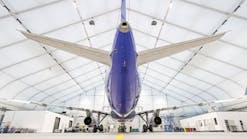Carnegie Mellon University Teams Up With PIT’s xBridge for ‘Smarter’ Cleaning
A group of Carnegie Mellon University students aim to use advanced technology to increase the efficiency of one of the most basic functions at Pittsburgh International Airport: restroom cleaning.
The project is the latest collaboration between the airport and the tech-forward university, this time under the umbrella of the airport’s xBridge innovation center. The airport and CMU signed an agreement in 2018 to work together to enhance traveler experiences and airport operations.
The goal of the latest project? To calculate real-time, smarter cleaning schedules using artificial intelligence that takes into account when and where flights are coming in, how many people are using a restroom based on a beam that counts people as they approach, and, eventually, sensors that alert staff when soap needs to be refilled and garbage needs to be emptied.
A single flight arrival at a gate can dirty a nearby restroom, while restrooms that haven’t had any flights at nearby gates might not need to be cleaned as quickly.
“We’re not just a bunch of students fumbling around to be on a project to maybe get some educational experience. We’re really here trying to think hard about what’s going to push the needle and make things better,” said Alex Shypula, 26, one of the graduate students on the CMU team.
“We use fancy words like machine learning and artificial intelligence, but trying to take those technologies and actually get them into the real world, it takes a lot of effort. It takes time; it takes hard thinking, [by] both the people trying to scope out the project and also the students and their advisors to work on and implement these things. We really want to make an impact.”
The students are part of CMU’s Master of Science in Artificial Intelligence and Innovation program and have been working with the airport since the fall. The business analysis was done as part of a course in AI innovation, and the technical development is a spring term capstone course, all under the direction of professor Michael Shamos. The course contains six different projects, all sponsored by different companies or organizations, like Pittsburgh International Airport.
Students ranked which project they wanted to work on. Shamos said the airport project was by far the most popular choice, with more than a third of the class ranking the airport project first on their list.
“It was a public service, and there are a lot of people in our program who are very concerned about using AI for public good. Public good not only means not evil, but it also means things that benefit lots of people, as opposed to systems that are built for a private company to increase its profits. And so anytime we have a governmental or non-governmental agency, that tends to attract,” Shamos said. “The other thing is I think they were very interested in the multimodal nature of the data in working with the airport.”
All of the teams in the class will be graded on their projects, and they will also be competing for prize money. In May, a panel of judges will select a winning team to receive a cash prize of $2,000 per student. Second prize nets $1,000 per student.
Shamos said the airport project is developing “a predictive AI system that takes all these disparate forms of data and develops a cleaning plan for the limited staff that the airport has. It was focused largely on restrooms because they’re the ones that get dirty quicker, but of course, the public areas do have to be cleaned too.”
The CMU students working on the project include Xiaoyu Zhu, Zhongyan Lu, Tianyu Xu, Yifan Chen, Zach Kitowski and Shypula.
“It was interesting to me to see how much the airport really is invested into new technology and trying to really put that at the forefront of how they do operations, how they build things, how they run the airport,” said Kitowski, 24. “I think that’s been very interesting because I don’t know if other U.S. airports are doing the same. I think it’s going to pay off, especially (post-pandemic). The ones putting a focus on innovation are really going to shine.”
Katherine Karolick, the airport’s senior vice president of information technology and leading the xBridge innovation center, said the CMU project can improve the customer experience with even cleaner facilities — while also saving money.
“What’s really interesting is that we’re doing this through leading-edge technology. This is technology not used in U.S. airports today,” Karolick said, noting the mix of Internet of Things devices with the airport’s LoRaWAN and AI.
“We can bring all of these components together for innovation, and that made it very desirable for the students because they know they’re stepping into an environment where they can innovate. We are thrilled to have these young, brilliant students in this program, which is hugely impressive with some of brightest AI thought leaders out there.”
The Carnegie Mellon University partnership is in addition to three homegrown tech firms that previously joined PIT’s xBridge. The three firms — Zensors, Carnegie Robotics and RE2 — join Fortune 100 company Honeywell in selecting xBridge as the ideal place to collaborate and innovate.
The xBridge is a 10,000-square-foot innovation center custom-built to nurture the evolution of the aviation industry and inspire creative solutions to its many challenges.
Commonly found in the tech sector, innovation centers bring various aspects of the product development process together into one space devoted to maximizing brainpower, resources and testing new ideas in real-time.
Earlier this year, the airport announced its partnership with Honeywell. The global company is using the xBridge to develop a live dashboard measuring air quality, which will help airport staff identify and correct issues in real-time. Based on the success of pilot systems, PIT may expand that technology throughout the airport.
“The amount of data that can be consumed at an airport is significant. If we capture it and manipulate it thoughtfully, we can create significant insights that enable us to take smarter actions, not only reducing costs and creating efficiencies, but also improving the passenger experience,” said Nick Anthony, director of data and analytics at the airport.




